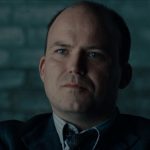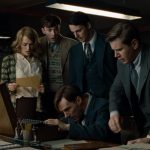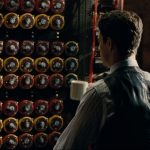The Imitation Game – 2014
I liked this movie. However, people that I have talked to have told me that it was so good that they watch it over and over again, and I don’t get that. I mean, it was good, but it wasn’t quite on that level. Benedict Cumberbatch did a fantastic job as the man who, in many ways, saved the world from the Nazi threat in WWII. He was Alan Turing, the genius who broke the unbreakable Enigma code used by the Germans, thus allowing the Allies to win the war, which they had, until then, been losing.
Unfortunately there are two reasons why few Americans have ever heard of him. First, when it comes to wartime espionage and code-breaking, secrecy is paramount. While he and his team were working to find a way to decipher the encrypted enemy messages, nobody could know what they were doing. In fact, it was a very important plot point to the film that when they finally succeeded, nobody could know they had done it. They even had to let British soldiers die in order to keep the secret.
The second reason nobody knows who Alan Turing is, is that he was a homosexual. In the United Kingdom in the 1940s, being gay was a crime, and Alan was shamefully arrested and convicted. He was sentenced to hormonal therapy which lowered his libido and made him impotent. According to the film, he eventually committed suicide because of the treatments, though the historical accuracy of this may be in question. His death by cyanide poisoning might have been accidental. I liked that the movie didn’t shy away from Turing’s homosexuality, but also that it wasn’t the focal point of the film either, though it was certainly important. Cumberbatch and Knightly both did a great job, as did their co-stars. And lest I forget, both Charles Dance and Mark Strong played very memorable supporting roles
In the film, two stories were told. One takes place during the war as Turing and his team work to break the Enigma Code. The other takes place after the war as a Detective Nock, played by Rory Kinnear, becomes obsessed with investigating Alan’s military records, only to find that he has none. It is here that the story of Alan’s sexual orientation is discovered, leading to his arrest, and setting us up for the movie’s tragic ending. However, this second plot line really takes a back seat to the first. We are also treated to a little back-story on Alan as a young man, played by Alex Lawther, where the seeds of his homosexuality are made clear.
Cumberbatch was simply brilliant. He portrayed Turing as a fascinating and complex character. He was so smart that he looked at his fellow human beings as beneath him. They would speak to him, and he would only answer if he considered what they said relevant enough to warrant a response. He was socially inept, arrogant, rude, and dismissive. The trouble was that most of the time, he was right. He got a job working at the top-secret British military cryptography installation at Bletchley Park.
There, he meets fellow cryptographers, Hugh Alexander, John Cairncross, and Peter Hilton, played respectively by Matthew Goode, Allen Leech, and Matthew Beard, among others. It was their task to break the Enigma Code, but because of the way it worked, two things made it unbeatable. First, The messages were written on a special machine which had five rotors and ten plug board cables. I don’t pretend to understand what that means, but the end result is that every intercepted German message had roughly 159,000,000,000,000,000,000 different possible combinations of letters and numbers. And because the settings used to write the messages changed every night, the team of cryptographers had eighteen hours to decode the messages before they became obsolete.
But knowing that he was better at deciphering encoded messages than any of his co-workers, he conceived of a very large and very expensive machine that would be able to do it all for them. Everybody believed he was out of his mind, but he never wavered in his surety that he was once again right. After he completes the machine, it still doesn’t work because it can’t be done in under eighteen hours. When Alan is given leadership of the team, he hires a woman named Joan Clarke, played by Keira Knightly, who is nearly as brilliant as he is. She is like a kindred spirit. He recognizes her brains and she makes him more likeable.
To make a long story short, they find a way to make the machine work faster and Enigma is broken. Of course, the breaking of the code was really the movie’s climax, and it was very exciting to watch. They then wrestle with the moral dilemma of how to use their new power. There is a subplot about Alan and Joan’s relationship. Alan proposes to her to prevent her from leaving the team, but then, in an effort to protect her from a deepening web of secrets, conspiracies, and lies, he breaks it off. The film implies that the two had a real emotional connection with each other, but I have learned that their reality was not so romantic. Oh well. I guess it isn’t the first time Hollywood has done that kind of thing, nor will it be the last.








